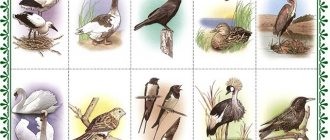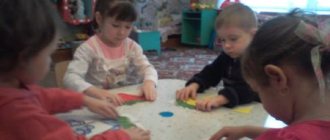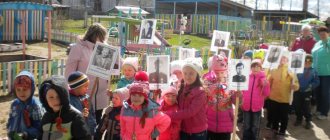Project in kindergarten “Victory Day”. Junior group
Short-term creative project in the junior group of kindergarten for May 9 “This Victory Day”
Problem: children’s ignorance of the holiday - Victory Day, about veterans of the Great Patriotic War. Justification of the problem: 1. Insufficient attention of parents to the holiday - Victory Day. 2. Children have no knowledge about the Second World War, or about the existence of a holiday in Russia - Victory Day. Project type: social and creative. Project type: short-term. Project participants : children of the junior group “Kolobok”, teachers, parents. Goal: Formation of moral values. Objectives: 1. Provide children with initial information about the Great Patriotic War. To provide knowledge about the defenders of the fatherland and the functions of the army. 2. Activate auditory and visual analyzers, develop speech, imagination and thinking in children. Develop skills to interact with each other, encourage children to collaborate. 3. To instill in children pride and respect for WWII veterans, a sense of pride for the Motherland, and the ability to listen to adults. 4. Activate the vocabulary: Motherland, hero, veteran, victory, soldier, army, defender. Expected results: 1. Children's interest in the topic “Victory Day”, manifestation of their cognitive activity. 2. Children independently take the initiative: look at illustrations, participate in conversations, ask questions; show creativity and detail in their work. 3. They enjoy drawing and playing. 4. Participation in joint activities of parents. Project activity product: Group and reception design; creating a relief composition with children “This is the kind of fireworks we have!”; sliding folder for parents “May 9 – Victory Day”, design of the newspaper “Thank you to grandfather for the victory” (drawings on the topic). Project implementation: 1. Work with parents: - folder - moving “May 9 – Victory Day”; — conversation: “What forms of work can be used when introducing children to the Victory Day holiday”; - design of the newspaper “Thank you to grandfather for the victory” 2. Work with children (see appendices): 1. Review of material on the topic “Victory Day”, postcards “Cities of Heroes”, illustrations and albums “The Great Patriotic War”; 2. Conversation “Getting to know the holiday”; 3. Drawing “This is the kind of fireworks we have!”; 4. Reading poems on the topic “Victory Day”; 5. Laying out fireworks, an airplane, a tank from counting sticks (you can use the overlay method); 6. Outdoor games: “Find your color”, game with handkerchiefs “Find yourself a pair” (to music); 7. Finger gymnastics “This finger”; 9. Breathing exercises “Flag”; 10. Physical school; 11 Application “Boat” 12. Role-playing game “Sailors”; 13 Musical entertainment “We want to be soldiers” Result of the work: 1. Collective work with children “This is the kind of fireworks we have!”; 2. Design of the newspaper “Thank you to grandfather for the victory” (together with parents).
APPLICATIONS
Conversation “Getting to know the holiday” Objectives: To give children knowledge about the holiday “Victory Day”, about how the Russian people defended their country during the Great Patriotic War, how the living remember them; activate the emotional sphere of children and thereby make them want to participate in the conversation. Activation of all mental processes by asking children questions. Enrichment of vocabulary. To cultivate respect and love for people who defend the Motherland from enemies, war veterans, and take care of them. Progress of the conversation. Educator: May 9 is the most important holiday celebrated in our country. What holiday is it? what kind of victory is this? Over whom? Victory Day is the greatest and most important holiday both for Russia and for many other countries of the world. It was very difficult not only for Russian soldiers and officers, but also for all residents of our Motherland, adults and children, during the war. The army, with the help of the people, defeated the enemies and drove them out of Russia, and then from other countries. On Victory Day, people lay wreaths and flowers at military monuments. Now listen to the poem: Today is a holiday - Victory Day! Happy, bright spring day! All the streets are dressed in flowers and sonorous songs can be heard. Educator: It was a terrible and long war. Early on a June morning, Nazi Germany attacked our peaceful country. The entire people rose to defend the Motherland, including our army, women, old people, even children. (During the course of the conversation, the teacher gives an explanation, approves the children’s answers, summarizes them, shows visual material, etc. The conversation should be emotional, lively, and increase the children’s activity. During the conversation, the teacher provides new information in order to clarify or deepen the children’s knowledge about those objects and phenomena in question.The vocabulary work techniques used are the teacher explaining the meaning of individual words, repeating the word in chorus together with the teacher). Our brave soldiers did not allow the Nazis to approach Moscow, but themselves went on the offensive. This war was difficult, difficult and terrible; many people died in it. But the long-awaited Victory Day has arrived. Our valiant warriors drove out the Nazis and themselves came to Berlin. This happened on May 9, 1945. And since then, every resident of our country and residents of other countries celebrate this holiday. May holiday - Victory Day Celebrated by the whole country Our grandfathers put on military orders. (T. Belozerov)
In this war, as I already said, not only adults, but also children took part.
Writers and poets wrote many poems and stories about their exploits. Our people fought bravely and won. But not everyone lived to see the Great Victory. So that no one forgets the valiant heroes and their exploits, many monuments were built throughout the country in memory of war heroes, mass graves in which soldiers killed in battle were buried (show illustration). There are few participants in the war left: many years have passed since the Victory Day. Our government takes care of its heroes and helps them. You, too, must treat the war veterans and all older people with respect and gratitude. They defended our Motherland and preserved peace on Earth. And we have one Motherland. Reading the poem: If they say the word Motherland, the old house immediately comes to mind, there are currants in the garden, A thick poplar at the gate.
By the river there is a modest birch tree And a daisy hillock... And others probably remember their native Moscow courtyard. The first boats are in the puddles, Where recently there was a skating rink And a loud, joyful whistle from a large neighboring factory. Or the steppe red with poppies, the golden virgin lands... The homeland can be different, but everyone has the same one! Take care of your Motherland, grow up honest and courageous, brave. Drawing “This is the fireworks we have!
Tasks . Arouse interest in drawing fireworks in collaboration with the teacher. Create conditions for experimenting with different materials. Mastering the “print” method (printing) and drawing using a stamp. Learn to draw in unconventional ways - make prints with a rag, a cotton swab, a cork and a star made of carrots; navigate on a piece of paper. To cultivate interest in observing beautiful phenomena in the surrounding world and displaying impressions in artistic activities using accessible visual and expressive means. Preliminary work. Looking at images of fireworks. Games with colorful balls. Mastering the “print” method. Materials, tools, equipment. The basis for the collective composition is a sheet of large format paper, gouache paints, materials for experimenting with prints - cotton pads, swabs, rags, corks, signets, carrot stars. Content. The teacher reads O. Vygotskaya’s poem “Salute” to the children:
Everything was quiet around, And suddenly - fireworks! Firework! Rockets flashed in the sky, both here and there! Above the square, Above the roofs, Above the festive Moscow The living fountain soars higher and higher than the lights! Out into the street, out into the street Everyone runs joyfully, Shouting: “Hurray!” Admire the festive fireworks! The teacher lays out on the table the basis for the collective composition - a sheet of dark blue or dark blue paper. He says: “This is heaven! Where are the fireworks? He takes one by one different materials prepared for experimentation and begins to make imprints, saying: “I take the cork, dip it in the paint and... slap (puts an imprint) - it turns out to be a light! I take a star, dip it in paint and... slap (puts an imprint) - what a sparkle! Encourages children to experiment with different materials. Helps with the “hand in hand” technique, gesture, word. Children choose materials for drawing at their own discretion. At the end you can read the excerpt: There are festive fireworks in the sky, Fireworks here and there.
Reading poems on the topic “Victory Day”
Let there be peace, Let the sky be blue, Let no smoke billow in the sky, Let the menacing guns be silent And the machine guns not fire, So that people and cities can live. Peace is always needed on earth
Victory Day The May holiday - Victory Day - is celebrated by the whole country. Our grandfathers put on the Military Orders. In the morning the road calls them to the solemn parade, And grandmothers look after them thoughtfully from the threshold. T. Belozerov What kind of holiday? (N. Ivanova) There are festive fireworks in the sky, Fireworks here and there. The whole country congratulates the Glorious Veterans. And the blooming spring gives them tulips, gives them white lilacs. What a glorious day in May?
Our whole country greets May joyfully. Spring is coming along the roads of the Motherland again. Hello, hello, Warm, clear, Victory Day, Beautiful day.
Thank you, our beloved Motherland, for all your worries and deeds, for the clear sun, for the blue sky, for everything that you gave to the children!
Victory Front-line songs, Military awards, Red tulips, Meetings of veterans And fireworks in half the sky, Huge as Victory. Victory Day has come to us, the best holiday on earth. Lots of fun today for both kids and kids! M. Poznanskaya
The boundless distances are in radiant color, And songs ring across the vastness of the country. Both the sun and the song were defended in battle by the Heroes of a long-defunct war. M. Gettuev
Outdoor game "Find your color." Goals of the game: development of coordination of visual, auditory and motor analyzers, training of the mobility of nervous processes, the ability to navigate in space and distinguish colors, raising the mood. What you need for the game: flags of different colors, tokens of the same colors, chairs according to the number of children. Progress of the game. Attach flags to chairs (or place them on chairs) that are placed in different places in the room. Give each player a token of the same color as the flags. After the words “Go for a walk,” the children disperse throughout the room. But as soon as the words “Find your color” are said, they must gather near a chair with a flag of the same color that matches the color of their tokens, and everyone must name that color.
Game with handkerchiefs “Find yourself a match” (accompanied by music) Goals of the game: development of coordination of movements, sense of rhythm, formation of correct posture and training of the vestibular apparatus, training of the mobility of nervous processes, the ability to distinguish colors, raising the mood. What you need for the game: handkerchiefs of different colors according to the number of children. Progress of the game. Give each player a handkerchief of a different color. When the music plays, children dance freely, performing different movements. After the words “Find yourself a partner,” the children disperse throughout the group and approach the child with whom they share the same color of scarf. Everyone should name this color.
Finger gymnastics “This finger” This finger is grandpa, This finger is grandma, This finger is daddy, This finger is mommy, This finger is me, That’s my whole family. Children are asked to bend the fingers of their left hand into a fist, then, while listening to the nursery rhyme, straighten them one by one, starting with the thumb.
Breathing exercises “Flag” Goals: strengthening the orbicularis oris muscle; training the skill of proper breathing; formation of deep rhythmic exhalation. Equipment: red flag. Look, my friend, this is our flag! Our flag is beautiful, bright, bright red. The teacher demonstrates the correct execution of the exercise: inhale through your nose, purse your lips and blow for a long time. Repeat 4-6 times.
Physical school Everything was quiet around. (Stand up straight, lower your arms) And suddenly - fireworks! Firework! (Raise your hands up) Rockets flashed in the sky (Open your fingers like a fan, wave your hands above your head left and right). both there and here! Above the square, above the roofs, (Sit down, stand up, raise your hands with open fingers up 2-Zraza) Above the festive Moscow The living fountain soars higher and higher than the lights. Out into the street, out into the street (Easy jogging in place). Everyone runs joyfully, shouting: “Hurray! ", (Raise your hands up and shout “Hurray”). Admire (Open your fingers like a fan, wave your arms above your head left and right) To the festive fireworks!
Role-playing game “Sailors” Goal: To develop the ability to perform several game actions, united by a plot outline, with the help of an adult. Learn to act independently in improvisation. Foster friendly relationships and a sense of teamwork. Vocabulary work: anchor, captain, ship, helm, helmsman, sailor. Previous work: reading fiction about ships, sailors, viewing photographs and videos about the sea, sailors, ships. Equipment: naval collar, captain's cap, medical gown, anchor, steering wheel, binoculars, building material. Progress of the game:
- Guys, I propose to go on a trip together today.
What can you go on a trip with? (By plane, by train, by car, by ship) - To travel on a ship, what do you need to do? (Build a ship) - What will we cost the ship from? (From a large wooden builder and soft modules) Children, together with the teacher, build the side of the ship, place a steering wheel on the deck, install a gangway, an anchor, and seats for passengers. - The ship is ready. Who's on the ship? Who needs what for work? (The teacher takes on the role of captain and helps distribute the roles of who will be who. Then you can invite one of the children to be captain). Children: For the captain - binoculars, for the sailors - caps, for the doctor - a suitcase with tools, medicine, for the cook - dishes and food. - What is the captain doing? Determines the course of the ship and gives commands. Right hand drive, left hand drive! Full speed ahead! The helmsman is at the helm. The sailors are scrubbing the deck. The radio operator reports the movement of the ship. A doctor monitors the health of the crew on the ship. The cook prepares food for the whole team. The music “Sound of the Sea” plays. The captain gives the command: “Everyone get ready to sail, undergo a medical examination.” The doctor examines the entire team. After being cleared for navigation, the team boards the ship. The captain gives the command: “Passengers take their seats!” They take up space on the ship. The captain gives the command: “Raise anchor! Raise the ladder! Full speed ahead! " The captain constantly gives commands to the helmsman: “Full speed ahead!” Turn to the left! The captain asks the cook to prepare lunch for the crew. The sailors saw that there was land ahead. The captain leads to the pier, the Navigator is at the helm (Children put their palm to their forehead, peer into the distance). Everyone returns home, the passengers, the doctor, the sailors leave the ship first, the captain is the last to leave. Downloaded: 60 times


